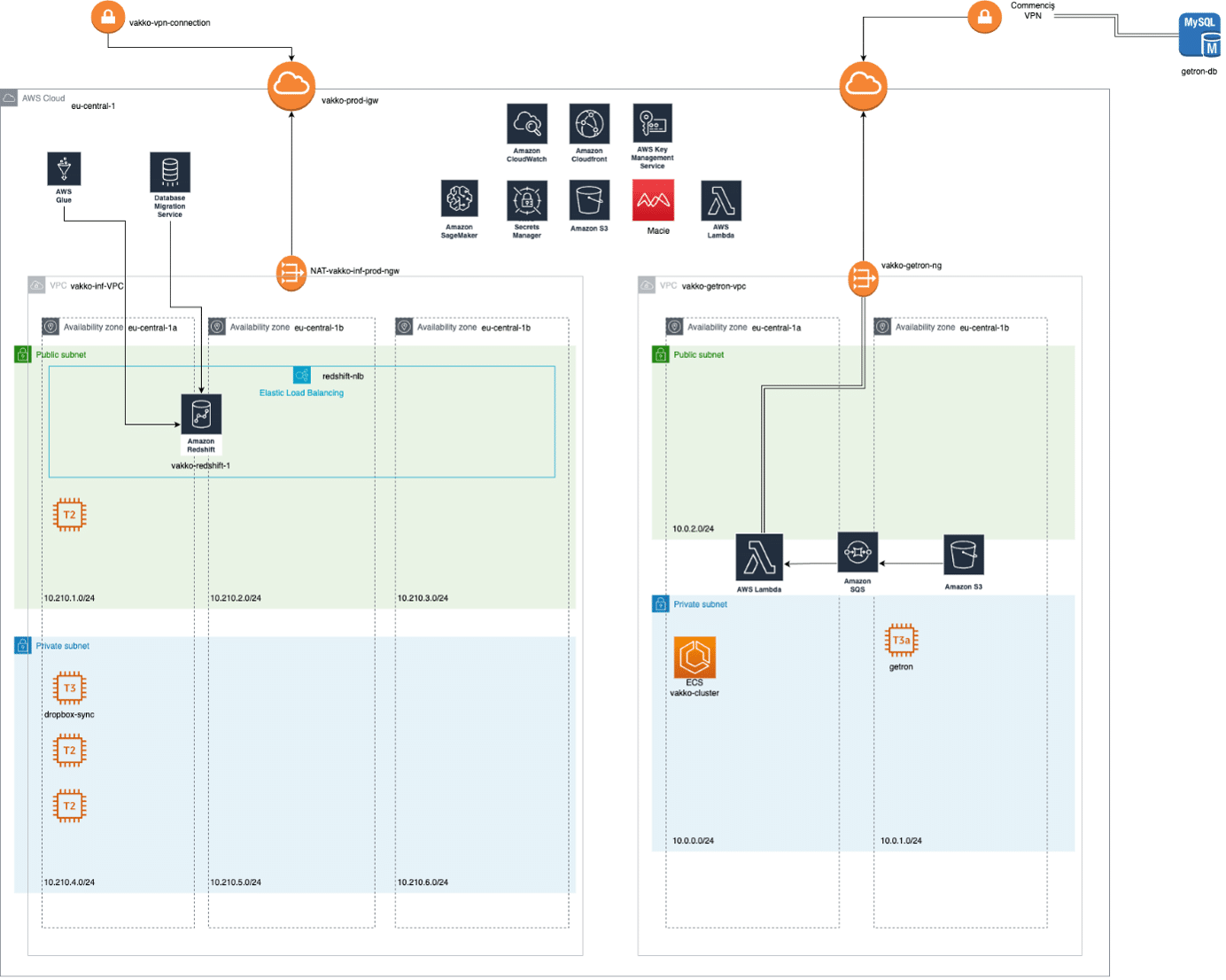Vakko Enhances Data Analytics with AWS Redshift for Improved Decision-Making
Vakko transformed its data analytics with AWS Redshift, integrating diverse data sources for improved decision-making in fashion and lifestyle operations, supported by seamless integration with AWS Lambda, S3, and Glue, ensuring high performance and cost-efficiency.
Vakko
About the customer
Vakko, one of Turkey’s well-established and premier luxury fashion brands, elegance, and sophistication in the world of fashion and luxury goods. Founded in the early 20th century, Vakko has long been celebrated for its exquisite craftsmanship, innovative designs, and dedication to quality. The brand began as a small hat shop, has since expanded into a wide range of fashion offerings including clothing, accessories, and home goods. Vakko became a household name in Turkey by the mid-20th century and has consistently maintained its reputation as a leader in the luxury sector.
Vakko’s commitment to excellence was recognized nationally when it was awarded the “Luxury Brand of the Year” at the Luxury Lifestyle Awards in 2015. Globally, Vakko continues to make its mark, showcasing Turkish luxury craftsmanship at global fashion weeks and through its stores in various international capitals as well.
As of 2023, Vakko operates over more than 150 retail outlets throughout Turkey, including flagship stores in Istanbul’s most prestigious and well-located shopping districts. The company’s headquarters and main production facilities are located in Istanbul Turkey, employing over 1,000 skilled artisans and staff. Vakko also collaborates with renowned designers from France, Italy, and the UK and more, ensuring that each collection reflects global fashion trends while staying true to its unique heritage.
Customer Challenge
Vakko, fashion and lifestyle brand, was encountering multiple challenges with its data management and analytics systems, particularly in handling the huge amounts of data generated from various operational areas including eCommerce, CRM, and customer services. The company required a solution to unify its data streams for improved analytics, reporting, and decision-making processes.
Firstly, data Integration and Scalability, Vakko’s legacy systems were not equipped to efficiently process or analyze the increasing volumes of data generated from multiple channels, including online sales, customer interactions, and backend operations. The existing infrastructure lacked the capability to scale effectively during peak traffic periods, particularly during new product launches and promotional campaigns, leading to delays in data availability and reporting.
Secondly, Real-Time Data Processing: The dynamic nature of the fashion industry and the need for real-time market and consumer insights placed a substantial demand on Vakko’s technology stack. The existing systems were unable to provide real-time analytics, which are crucial for timely business decisions and maintaining competitive advantage.
Another important topic was Cost-Efficiency, managing an on-premises data warehousing solution was proving to be cost-prohibitive. The infrastructure required frequent upgrades and maintenance, which were both costly and disruptive to daily operations.
With the increasing focus on consumer data protection regulations, Vakko needed to ensure that its data handling practices were compliant with international data security standards. The existing systems needed an overhaul to improve data security, governance, and compliance protocols.
As a result, recognizing these challenges, Vakko turned to AWS Redshift to leverage its powerful data warehousing capabilities which would allow integration of diverse data sources into a centralized platform. AWS’s scalability and managed services like Lambda for data processing, and Data Migration Service (DMS) for seamless integration, provided the required infrastructure that adapts to the variable loads, ensuring consistent performance and scalability while minimizing costs. Moreover, AWS’s pay-as-you-go model offered a cost-effective way to manage data warehousing expenses, aligning operational costs directly with business growth and data usage, thus avoiding the sunk cost and complexity of maintaining on-premises hardware. These strategic moves are aimed at transforming Vakko’s data architecture into a more agile, secure, and performance-oriented ecosystem, thereby supporting the company’s objectives of driving innovation and superior customer engagement through data-driven insight.
How the solution was deployed to meet the challenge
Phase 1: Discovery
- We conducted an extensive assessment of Vakko’s existing data infrastructure to identify key areas of improvement, focusing on integration, scalability, real-time processing, cost efficiency, and security.
- A new data architecture was proposed, utilizing AWS Redshift as the central data warehouse to consolidate data from diverse sources for advanced analytics.
- We also reviewed Vakko’s security requirements to ensure that the solution complied with data protection regulations and industry standards.
Phase 2: Implementation
- Redshift Configuration: Configured a Redshift cluster optimized for Vakko’s data volume and query complexity. This setup was designed to handle high throughput and complex query scenarios typical in the retail industry.
- Data Migration: Employed AWS Data Migration Service (DMS) for the seamless integration of data from Oracle, MS SQL Server, and various other systems into the Redshift data warehouse.
- ETL Processes: Developed Lambda functions for real-time data processing. This allowed for the immediate availability of data in the warehouse, supporting real-time analytics.
- Data Integration and Validation: Ensured that data flowed from source systems to Redshift accurately and efficiently. Utilized AWS Glue for orchestrating the ETL processes and ensuring that data formats and schemas were consistent across sources.
- Implemented VPCs to isolate the Redshift cluster and control access with strict security group rules. In addition, applied encryption in transit and at rest using AWS’s built-in security mechanisms to protect data integrity and privacy and lastly, enabled logging and monitoring using AWS CloudTrail and Amazon CloudWatch to provide visibility into operations and performance.
- Leveraged Redshift’s ability to scale computing resources up or down as needed to manage costs effectively without sacrificing performance. Also utilized reserved instances for predictable workloads to further reduce costs.
Additional Components
- HA and DR: Configured Redshift snapshots and replication to secondary regions to ensure data durability and high availability.
- Performance Optimization: Implemented performance tuning practices on Redshift such as distribution styles and sort keys to optimize query performance.
- Business Intelligence Integration: Connected Redshift with Amazon QuickSight for business intelligence and reporting, enabling stakeholders to derive insights directly from their data through interactive dashboards.
Third party applications or solutions used.
The phased rollout of AWS Redshift allowed Vakko to transform its data handling capabilities, providing a robust platform for real-time business intelligence that drives strategic decisions and enhances operational efficiency. Third party applications or solutions used.
OpenMeteo: OpenMeteo is integrated within Vakko’s weather data architecture, which is hosted on AWS Cloud. This service is crucial for providing real-time weather forecasts that Vakko utilizes to plan operations and adjust customer service strategies according to changing weather conditions. The integration of OpenMeteo through its API ensures that Vakko can access up-to-date meteorological data, which is processed and stored in AWS services for analytical and operational use, enhancing the company’s ability to make informed decisions rapidly.
Soup and Requests: Beautiful Soup and Requests libraries are deployed on AWS EC2 instances as part of Vakko’s web scraping project. Beautiful Soup is used for parsing HTML and XML documents to extract data efficiently, while Requests is utilized for making HTTP calls to websites. This combination provides Vakko with powerful tools for web data extraction, critical for gathering market intelligence and competitive information. The deployment of these libraries ensures that Vakko can maintain a robust database of web-derived data, supporting strategic marketing and business decisions.
Sor’un: Sor’un is deployed to enhance Vakko’s customer interaction capabilities via WhatsApp. It plays a pivotal role in managing customer service communications, enabling automated and real-time interactions. The integration of Sor’un helps streamline communication processes, ensuring high availability and efficient message processing, which are vital for providing quick and effective responses to customer inquiries. This setup not only improves the overall customer service experience but also integrates seamlessly with Vakko’s other systems for enhanced operational efficiency and customer satisfaction.
AWS Services used as part of the solution.
- Amazon VPC: Used to provision a logically isolated section of the AWS Cloud where Vakko can launch AWS resources in a defined virtual network. This virtual network closely resembles a traditional network that Vakko would operate in their own data center, with the benefits of using scalable infrastructure on AWS.
- Amazon S3: Utilized for storing and retrieving any amount of data at any time, from anywhere on the web. For Vakko, S3 hosts web scraping results, logs, and serves as a data lake for storing unstructured data.
- EC2: Provides scalable computing capacity in the AWS Cloud. Vakko uses EC2 instances to host applications and services, such as the web scraping tools and backend servers for their e-commerce platforms.
- Amazon EBS: Offers persistent block storage volumes for use with Amazon EC2 instances. EBS volumes are used by Vakko to store database and application logs, providing high availability and durability.
- AWS IAM: Manages access to AWS services and resources securely. Using IAM, Vakko can control who is authenticated (signed in) and authorized (has permissions) to use resources.
- AWS Lambda: Allows Vakko to run code for virtually any type of application or backend service with zero administration. Lambda is used to automatically run code in response to multiple events, such as modifications in data within S3 buckets or updates from other AWS services.
- Amazon Redshift: Acts as a fully managed, petabyte-scale data warehouse service in the cloud. Vakko uses Redshift to analyze all their data across data warehouses and data lakes.
- AWS Glue: A fully managed extract, transform, and load (ETL) service that makes it simple for Vakko to prepare and load their data for analytics. Glue is used to catalog Vakko’s data and automate the ETL processes.
- Amazon Athena: An interactive query service that makes it easy to analyze data in Amazon S3 using standard SQL. Vakko uses Athena for quick, ad-hoc querying of their unstructured data stored in S3.
- Amazon QuickSight: Used for business intelligence to create and publish interactive dashboards. QuickSight is integrated with Redshift to provide insights and visualizations of the warehouse data to Vakko’s business users.
- AWS CodePipeline & CodeBuild: These services are used to automate Vakko’s continuous integration and continuous delivery (CI/CD) pipeline for deploying applications on AWS.
- AWS Secrets Manager: Helps Vakko protect access to applications, services, and IT resources. This service is used to manage secrets needed for the application that provides a secure method to store and manage sensitive information such as database credentials and API keys.
- Amazon CloudWatch: Used for monitoring and observability, CloudWatch provides data and actionable insights to monitor Vakko’s applications, understand and respond to system-wide performance changes, and optimize resource utilization.
- Amazon EFS: Provides a simple, scalable, and fully managed elastic NFS file system for use with AWS Cloud services and on-premises resources. EFS is used by Vakko for shared file storage for their EC2 instances and other applications.
Outcome(s)/results
Following the successful implementation of an AWS Redshift solution, Vakko has experienced significant enhancements across its data management and analytics infrastructure. The adoption of AWS Redshift has greatly improved scalability, enabling Vakko to effortlessly adapt to changing data demands and seamlessly integrate data from diverse sources including ERP systems, e-commerce platforms, and customer interaction channels.
As a result of transitioning to AWS Redshift, Vakko’s data environments have been transformed into scalable, cost-efficient, and reliable architectures. This transformation supports advanced data analytics capabilities that facilitate deep insights into customer behaviors, operational efficiency, and market trends. These insights are instrumental in driving strategic business decisions and optimizing operational processes.
Moreover, the deployment of additional AWS services like AWS Lambda for real-time data processing and AWS Glue for automated ETL workflows has further streamlined Vakko’s data operations. These integrations have enabled a more agile response to market conditions, improved the accuracy of predictive analytics, and enhanced the overall customer experience by providing more personalized and timely interactions. The comprehensive AWS solution, centering on Redshift, supports Vakko’s objectives of maintaining a competitive edge in the fast-paced fashion industry by harnessing the power of cloud computing and big data analytics.
Architecture Diagram
The Vakko deployment architecture features a secure and robust AWS cloud environment, meticulously designed to enhance connectivity and streamline operations. At the core of the architecture is a Site-to-Site VPN connection, linking Vakko’s corporate data center with the AWS cloud through VPN Gateways, ensuring secure data transmission. Public subnets within the architecture host Elastic Load Balancers and Amazon EC2 instances managed by Amazon ECS, optimizing traffic distribution and resource utilization. Essential data management services such as Amazon RDS (MySQL) and Amazon Redshift are strategically placed to support relational data storage and complex querying within these subnets.
The processed data is then moved through a series of Glue jobs, which are responsible for converting the XML format into a structured format suitable for analysis, storing the resulting data in Amazon Redshift. This setup ensures efficient handling of data workflows, where data integrity and transformation are maintained throughout the process, enabling Vakko to perform comprehensive analytics.
The architecture also emphasizes data integrity and availability through strategic backups and data synchronization tasks housed in private subnets, protecting sensitive operations from external threats. Amazon Macie is employed to enhance data security, automatically safeguarding sensitive information in Amazon S3. This comprehensive setup ensures that Vakko’s applications are not only scalable and reliable but also secure and compliant with industry standards, supporting the company’s continuous growth and digital transformation initiatives.
Technical Requirements
- Establish a VPN connection using AWS VPN Gateways to securely link the data center with AWS, ensuring data privacy and secure access.
- Deploy AWS Lambda for scalable, serverless computing.
- Use Amazon ECS for robust container management in a private subnet.
- Utilize Amazon RDS for relational database services and Amazon Redshift for data warehousing.
- Implement Amazon S3 for comprehensive object storage solutions.
- Implement Elastic Load Balancing to distribute traffic across EC2 instances in public subnets.
- Set up Amazon VPCs and NAT Gateways for enhanced network isolation and connectivity.
- Use AWS WAF and AWS Shield for protecting against web exploits and DDoS attacks.
- Integrate AWS Secrets Manager for secure handling of credentials and secrets.
- Employ Amazon Macie for sensitive data protection and AWS CloudWatch and CloudTrail for monitoring and logging.
- Establish mechanisms for regular data backups and synchronization to maintain data integrity and availability.
Conclusion
By leveraging AWS Redshift, Vakko has significantly enhanced its data analytics and management capabilities across its extensive fashion and lifestyle operations. The comprehensive and scalable features of AWS Redshift provided Vakko with the advanced tools necessary to integrate and analyze vast amounts of data from diverse sources efficiently. This deployment has successfully transformed Vakko’s approach to data-driven decision-making, enabling more accurate forecasting, customer behavior analysis, and inventory management. The effectiveness of AWS Redshift, coupled with the seamless integration of AWS Lambda, S3, and Glue, has fortified Vakko’s infrastructure, ensuring high availability, robust performance, and cost-efficiency. The success of this project exemplifies how AWS Redshift can be a cornerstone in revolutionizing enterprise data warehousing in a dynamic and competitive industry landscape.






